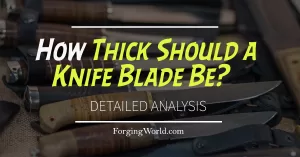There are many possible materials that you can make a knife out of. Some of them are better than others. In today’s article, we will talk about silver and its potential usage for knife making.
So, can you even make a knife out of silver? You can make a knife out of silver via stock removal or if it is cold-forged. The key factor is the intended use. If you plan on making a butter knife, then yes, silver is a great option. On the other hand, if you want a general knife for all purposes, then no, silver is not a good option as it is too soft to hold an edge.
As you can see, it typically depends on what you are planning to use it for. Next, we will dive into silver blades and whether you can harden them.
Let’s start.
Is Silver Good for Knives?
Silver is a nearly white, soft, lustrous, malleable, and very ductile precious metal. It is also a good conductor of electricity and heat. While it is not a chemically active metal it is still attacked by nitric acid and concentrated sulfuric acid. Silver usually requires regular cleaning and it is also stable in water.
The major use of silver, especially silver nitrate is found in photography, domestic uses such as cutlery, the electrical industries, jewelry, and mirrors. Silver doesn’t oxidize in air and it is stable in water. It is also known as a very expensive metal.
Typically, silver is not considered a good material for knife making, especially for heavy-duty purposes. It is too soft to hold an edge for more than a few uses. However, you can use silver for a nice table knife or for a fruit knife that doesn’t require a razor-sharp edge. Silver is also much more expensive than regular steel, so the production cost would be noticeably higher.
It may be interesting to mention here is that silver knives were popular in England in the 19th century. They were used to eating fruit because the acidity of fruit would not rust the knife. Back then there weren’t any stainless knives that are popular today.
If you are concerned about having a visually nice appealing blade that is also practical for general purposes, I would recommend using stainless steel instead. Even they may be similar at first look, they are very different in their properties. Stainless is much harder and has greater edge retention.
Stainless steel is composed of different alloys with different chemical compositions than sterling silver. The combination of steel and chromium offers strength and durability while offering resistance to corrosion and low maintenance.
On the other side, sterling silver is composed of 92.5% pure silver and 7.5% copper alloy. Pure silver has big chance of deforming because of bending, snagging and it can even end up broken. So, because of this, sterling is added which offers more functionality and durability than just pure silver.
As you can see, although both of them are alloy metals they still have huge differences that will affect your decision on deciding which one is better for knife making. With that said, stainless steel is a clear winner in terms of edge retention, durability, and longer lifespan. Sterling silver knives, on the other hand, are a superior option if you want to make a more elegant blade. Sterling silver is also more lightweight and holds more value.
Pros of a sterling silver knife
- Easily cleaned
- Offers more versatility and malleability
- Has more value
- Nice glassy look
- Good corrosion resistance
Cons of a sterling silver knife
- Softness
- Prone to scratches
- The higher cost of material
- Bad edge retention
- Bad durability
Can Silver Be Hardened?
As you may know, forged knives have always been preferred by knife makers and users. Heat treating of any alloy is vital to increase its strength and hardness. So, can the same thing be done with silver?
Although pure silver cannot be hardened, you can heat treat sterling silver to increase its strength and reduce its ductility. So, if you want to make a usable blade, use sterling silver instead of pure silver.
Next, I will describe the heat-treating process of a sterling silver knife.
Step 1)
Check the material for any solder joints that may be present. Heat it to 1292°F–1346°F (700°C–730°C) for 30–60 minutes. The goal here is to dissolve copper in the silver which will result in an annealed alloy.
Step 2)
Take it out from the forge and quench it in water. The quenching process produces a supersaturated alloy in which copper is still dissolved in silver but it is unstable. This increases hardness but it still weak and soft.
Step 3)
Place the blade in the forge again and heat it up to 572°F (300°C) for another 30-60 minutes. After cooling, hardness will range somewhere between 120-140dph. Note that if you used lower temperatures, you won’t achieve this level.
This allows the copper to precipitate from silver which initiates grain growth. This is also called aging. Newly formed large grains are the result of these new grains and now your blade is stronger and harder. Don’t make this process too long as you will make the blade softer and weaker.
Can a Sword Be Made of Silver?
We talked about the knives but what about a sword? Imagine creating a beautiful sword made of silver. Ok, I actually did and it is a beauty.
The question is, is it possible to make such a sword in real life?
Pure silver is a bad material to make a sword out of because it is way too soft and doesn’t retain a sharp edge. Another reason why you cannot make a sword out of pure silver is that it cannot be hardened. On the other side, sterling silver may be better for this purpose.
If you plan to make a sword for decorative purposes only, then you could use silver. Keep in mind that your production cost would be extremely high. Don’t forget that. Another option is to make a hybrid blade where the edges and points are steel and large sections of silver are inlaid into the blade.


